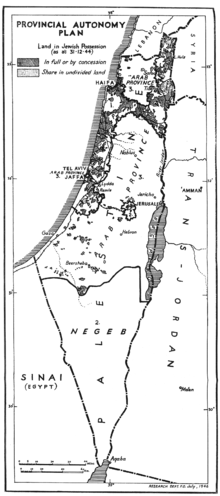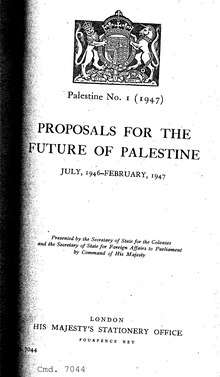Morrison–Grady Plan
The Morrison–Grady Plan, also known as the Morrison Plan or the Provincial Autonomy Plan was a joint Anglo-American plan for the creation of a unitary federal trusteeship in Mandatory Palestine, announced on 31 July 1946.[1]

Following the issuance of the Anglo-American Committee of Inquiry report on 20 April 1946, a new committee was created to establish how the Anglo-American proposals would be implemented, led by British Deputy Prime Minister Herbert Morrison and US diplomat Henry F. Grady.[2] Morrison presented the plan to the British Parliament on 31 July 1946.[3] In the United States, President Truman's initial support for the plan changed after American Zionist lobbying against it before the November mid-term elections.[4] The pressure from American Zionists resulted in President Truman rejecting the plan, despite it having been proposed by Truman's own appointee. The United States then had no Palestine policy.[5]
The plan became the point of departure for the London Conference of 1946–47, convened by the British on 1 October 1946.[6]
Details of the Plan

Under the terms of the plan, Jewish and Arab provinces would exercise self-rule under British oversight, while Jerusalem and the Negev would remain under direct British control.[7]
Reaction
The Arab states discussed the plan with the British at the London Conference of 1946–47; they rejected the plan on the grounds that it would lead to partition, and instead proposed an independent unitary state.[8]
The Jews refused to attend the conference, having rejected the provisional autonomy plan at a separate Zionist conference.[8] They made attendance conditioned on having their detained leaders released to represent them at the table (which the British did not permit).[9]
At a later meeting of the Conference the following February, Britain proposed a plan, known as the Bevin Plan, for a five-year British trusteeship. The trusteeship was to lead to a permanent settlement agreed by all parties. When both the Arab and Jewish sides rejected the plan, Britain decided to refer the problem to the United Nations. It set up the United Nations Special Committee on Palestine.[10]
Negev settlement
In response to the plan, the Jewish Agency decided to settle the Negev desert, in a scheme known as 11 points in the Negev.[11][12]
References
- Note that some sources describe the plan as the "Provisional autonomy" plan instead of Provincial:
- Cohen, Michael Joseph (1987). The Rise of Israel: The Anglo-American Committee on Palestine, 1945–1946. Garland Pub. ISBN 978-0-8240-4933-1.
Cabinet discussion, 25 July 1946, on the agreement between American and British experts on a 299 new policy for Palestine. (The new plan for provisional autonomy would become known as the Morrison-Grady plan, since Herbert Morrison would present it before the British Parliament.) Cab. 128/6
- PALESTINE, HL Deb 18 February 1947 vol 145 cc715–21: "From the outset both Arabs and Jews declined to accept as a basis for discussion the provisional autonomy plan put forward by His Majesty's Government." (compare vs. the same speech in the House of Commons: uses the word "Provincial"
- Cohen, Michael Joseph (1987). The Rise of Israel: The Anglo-American Committee on Palestine, 1945–1946. Garland Pub. ISBN 978-0-8240-4933-1.
- Cohen, Michael J. (14 July 2014). Palestine and the Great Powers, 1945–1948. Princeton University Press. p. 131. ISBN 978-1-4008-5357-1.
On June 11, Truman himself announced the formation of a cabinet committee on Palestine and other, related problems. The committee would be composed of Secretary of State Byrnes (chairman), Secretary of War Robert Patterson, and Secretary of the Treasury John Snyder. Henry F. Grady, a career diplomat, was appointed as Byrnes's alternate to head the American team dispatched to London to discuss details with the British
- Hansard PALESTINE, HC Deb 31 July 1946 vol 426 cc957-1075
- Arieh J. Kochavi (14 January 2003). Post-Holocaust Politics: Britain, the United States, and Jewish Refugees, 1945–1948. Univ of North Carolina Press. p. 130. ISBN 978-0-8078-7509-4.
Truman and his cabinet were at first inclined to support the provisional autonomy plan, but following intense pressure on the part of the American Zionists and mindful of the coming midterm elections in November 1946, the president changed his mind. On 7 August, he informed the British that he had decided to reject the plan.
- Michael J. Cohen (12 November 2012). Palestine to Israel: From Mandate to Independence. Routledge. p. 221. ISBN 978-1-136-28660-5.
Once again, Zionist pressures in Washington brought Truman's rejection of his own experts' report. The Zionists feared that the plan would crystallise their development within a narrow ghetto. But their rejection also condemned the DPs to spend another winter in Europe. Much as the Zionists played on the 100,000 issue, they predicated the refugees' salvation upon a satisfactory political solution in Palestine. Moreover, by now the numbers of DPs in the camps had more than doubled, and the Zionists pondered the wisdom of limiting their demands to 100,000. Truman's rejection of the Morrison-Grady plan left the United States with no Palestine policy at all.
- Hattis, Susan Lee (1970). The bi-national idea in Palestine during Mandatory times. Shikmona.
- Fred John Khouri (1985). The Arab-Israeli Dilemma. Syracuse University Press. pp. 36–. ISBN 978-0-8156-2340-3.
- Steven L. Spiegel (10 December 2014). The Other Arab-Israeli Conflict: Making America's Middle East Policy, from Truman to Reagan. University of Chicago Press. p. 24. ISBN 978-0-226-22614-9.
But the Jews did not attend because of poor British-Jewish relations in Palestine and British refusal to discuss partition.
- David A. Charters (12 June 1989). The British Army and Jewish Insurgency in Palestine, 1945–47. Palgrave Macmillan UK. p. 39. ISBN 978-1-349-19975-4.
The Jews refused to attend unless their detained leaders were released and allowed to represent them at the conference table. The British government refused to permit this...
- Ellen Jenny Ravndal (2010). "Exit Britain: British Withdrawal From the Palestine Mandate in the Early Cold War, 1947–1948". Diplomacy & Statecraft. 21 (3): 416–433. doi:10.1080/09592296.2010.508409.
- Efraim Karsh; Rory Miller (23 October 2013). Israel at Sixty: Rethinking the Birth of the Jewish State. Routledge. pp. 55–. ISBN 978-1-317-96776-7.
- Ilan Pappé (15 August 1994). The Making of the Arab-Israeli Conflict, 1947–1951. I.B.Tauris. pp. 52–. ISBN 978-1-85043-819-9.
Bibliography
- H. Levenberg, "Bevin's Disillusionment: The London Conference, Autumn 1946", Middle Eastern Studies, Vol. 27, No. 4 (October 1991), pp. 615–630
External links
- US Department of State (1946) Foreign Relations of the United States: Diplomatic Papers, 1946, Volume VII: The Near East and Africa. Washington, DC: Government Printing Office, pp. 652–667